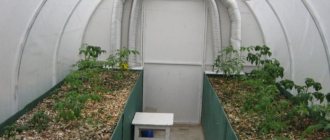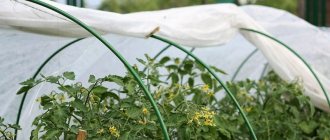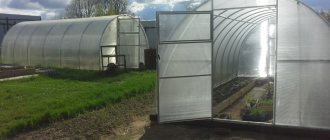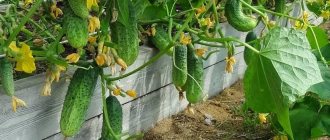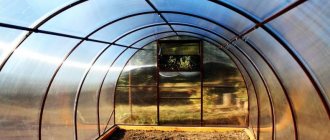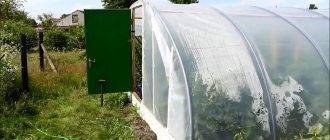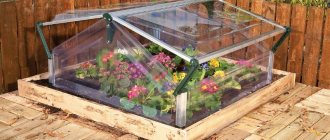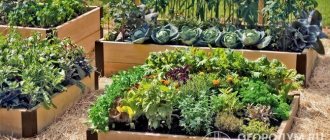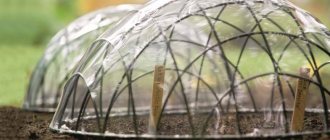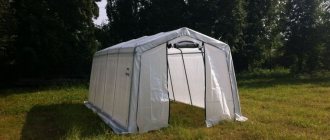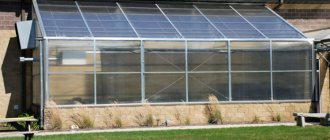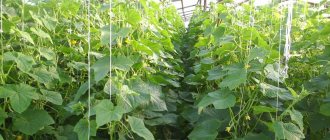Optimal greenhouse height
The optimal height in a greenhouse is generally 2.5 m. If a greenhouse with a gable roof is built, the walls of such a greenhouse should be at least 1.8-2 m high. In this case, it is convenient to work, you do not need to bend over, you can plant, for example, varieties tall tomatoes, or tomatoes of the determinate group, are not limited in growth.
Cucumbers or beans are directed upward, and thus you can make maximum use of the greenhouse area.
Greenhouse width. The optimal width of the greenhouse should be at least three meters. This will allow you to create a convenient central path and plant three plants in a row on the sides - the harvest will be greater!
If you buy a ready-made prefabricated arched greenhouse, in this case the width of the greenhouse may be smaller. We must remember that the wider the greenhouse, the lower the strength of its structure. This especially applies to greenhouses made of glass - glass is quite heavy.
Prevention of diseases and pests
In protected soil, it is very important to carry out timely prevention of pests and diseases that cause enormous damage to the crop. In cultivation facilities, the main method of protection is biological. The use of chemicals should be minimal. The main diseases of vegetable crops grown in protected soil are as follows:
- root rot;
- root rot;
- gray rot;
- white rot;
- powdery mildew;
- peronosporosis;
- olive spot;
- fusarium;
- ascochyta;
- anthracnose;
- bacteriosis;
- mosaic.
Pests of greenhouse cucumbers are represented by potato, melon and greenhouse aphids, as well as whiteflies, for the destruction of which the biological product "Actofit" can be used. For the purpose of prevention, treatments are carried out with the drugs “Ordan”, “Previkur”, “Quadris”, one percent Bordeaux mixture, “Fundazol” solution, copper oxychloride or drugs with a similar effect.
Material from which the greenhouse is built
A greenhouse frame made of wood is not only a generally affordable material, but also a material that has useful properties. Wood has low thermal conductivity, and wooden materials are easy to process. At the same time, there are also disadvantages - the short service life of wood due to high humidity and at the same time high temperature, all this is very typical for summer greenhouses.
In winter, the moistened wood of the greenhouse frame is subjected to severe frost testing. Regular painting does not help; it quickly crumbles over time. Special antiseptics used for wood help a lot. They protect against high humidity and temperature, and also have antimicrobial properties.
It must be remembered that under operating conditions of a greenhouse, some antiseptics are toxic indoors at high temperatures; this can cause allergies and headaches.
Greenhouse for cucumbers – buy or make it yourself?
Anyone who has decided to make a greenhouse on their property has a question: buy a ready-made structure or assemble it yourself. Both options have their advantages and disadvantages.
Advantages of ready-made greenhouses:
- you buy a finished product, which will be delivered and installed to you;
- no need to bother with finding material and assembling the greenhouse.
Disadvantages of ready-made greenhouses:
- the shape and dimensions cannot be changed, and the “standard” ones offered by the manufacturer are not always suitable for a particular site;
- high price.
At the same time the advantages of DIY greenhouses include the following:
- the ability to select materials, sizes and assemble any design;
- A greenhouse assembled with your own hands is easier to dismantle.
Disadvantages of greenhouses assembled by yourself:
- it takes time and effort to assemble;
- sometimes the cost of materials and effort expended is equal to the price of a finished greenhouse.
Aluminum greenhouse frames.
This frame is light, durable, quite plastic, and does not rust. The shelf life of aluminum greenhouses is very long, with minimal maintenance. But there is also a negative aspect - aluminum has high thermal conductivity and, as a result, additional insulation is needed. In our conditions, it is not unimportant to remember that aluminum is a non-ferrous metal, and it is sometimes stolen.
If you purchase a ready-made greenhouse made of aluminum or steel, pay attention to the presence of a special greenhouse profile in it. This kind of profile involves wide shelves used to support the glass. Glass can withstand fairly large loads, both impact and static, in the case where it can, it rests along the entire perimeter with its largest area (from 12 to 15 mm).
On the contrary, in the case where the support of the glass is 5-7 mm, and small loads can destroy the glass, this is especially unsafe when constructing a glass roof. It makes sense to pay attention to the strength of the profile for greenhouses.
Courage F1
The parthenocarpic universal hybrid Courage F1 is highly respected among summer residents. Approximately 40 days after the emergence of shoots, you can already harvest the first greens! The fruits appear uniformly and are stored well after being picked from the bush. From one plant you can collect up to 18 kg of crunchy and sweet fruits weighing up to 150 g. Growing requires regular watering and fertilizing. Also, to get a good harvest, the bushes need to be shaped. But the plant has strong immunity to common “cucumber” diseases (powdery and downy mildew, mosaic, olive spot).
What to cover with?
The materials used to cover the greenhouse are mainly film and glass. The glass can be either ordinary window glass, 4 mm, or special glass - greenhouse glass. A special feature of greenhouse glass is its high consumer properties. The cost of greenhouse glass is slightly higher than window glass. Glass must be cleared of snow in winter.
Film is a more economical option than glass, but lasts no more than two years. You should choose a film with a thickness of at least 1 mm. Reinforced film will, of course, last longer, although it is more expensive.
Winter design
For winter cultivation, early ripening hybrids that are suitable for hand pollination are more suitable for you. These are Almaatinsky-1 and Gribovsky-2 varieties, Bessemyanka and more modern options. Give preference to parthenocarpic hybrids if you don’t want to run around with a tassel and pollen, and in the summer – to ordinary bee-pollinated ones, whose fruits always appear smooth and beautiful.
But it is undesirable to grow in beds at such a time, because... the ground underneath them is still cold. It is better to use special pots or boxes, at the bottom of which be sure to organize drainage: expanded clay, small stones, pottery shards. This is necessary so that the water does not stagnate and cool there later.
Cellular polycarbonate is a modern material for covering greenhouses.
Polycarbonate is lightweight panels that have internal air cavities. Such panels are light, elastic, they do not break, and are rolled up. The thermal insulation of polycarbonate is not inferior even to double glazing in greenhouses, and at the same time they retain the heat accumulated during the day inside the greenhouse, and also protect the plants from overheating.
Greenhouses made of polycarbonate are durable and very frost-resistant, their properties protect against harsh ultraviolet radiation, and at the same time they have a modern, beautiful appearance.
Benefit F1
Benefit F1 is a parthenocarpic hybrid with medium-early ripening periods: the first green plants ripen 45-50 days after emergence. Not only greenhouses and greenhouses are suitable for cultivation, but also open ground. The fruiting period is long: the ripening of the crop continues throughout the summer. Productivity is more than 8 kg/sq.m.
The plant is highly branched, with a large number of side shoots. The root system is developed.
The greens are cylindrical in shape, bright green in color with light stripes, and have a coarsely tuberous skin. The length of the cucumber is 10-14 cm, the average weight is 100 g. The pulp is juicy, crisp, without bitterness or voids. The fruits are suitable for both fresh consumption and canning.
The hybrid is resistant to most cucumber diseases.
Tips for setting up greenhouses
- Paths in a greenhouse can be made from wooden boards, and they are treated with special disinfectants, otherwise they themselves will become a source of diseases and pests.
- Use light, portable, wide boards-paths to avoid walking on the soil in the greenhouse, not to compact the soil, and thus the plants will develop better.
- It is better to change the soil in the greenhouse every season mainly with a spade bayonet. This will give an increase in the harvest.
- When planting greenhouse plants, it is good to use compost or manure (for example, horse manure, with a small amount of straw); you can use humus peat.
- Alternatively, you can lay a layer of fresh green grass at the bottom of the ridge. The grass, like manure, will gradually burn out, releasing both the necessary nutrients and heat.
Butterfly greenhouse
The butterfly greenhouse (sometimes called “ Russian ”) is characterized by a convenient and simple design that allows rational use of the site area and provides easy access to plantings. Installations of this type are durable and reliably protect cucumbers and other crops from external influences and accidental damage. “Butterfly” can withstand strong winds, hail and a layer of snow up to 10 cm, and does not cast a shadow on the site. In addition, such a greenhouse is very easy to ventilate.
Maximum access to plantings in the butterfly greenhouse
A butterfly greenhouse consists of a box whose outline resembles a house with a gable roof. Both roof flaps can be opened, providing access to the interior and allowing the greenhouse to be ventilated. Such structures are sold ready-made, but you can also build them yourself.
Finished products by default consist of polycarbonate or glass and metal. Plus, you don't have to fiddle with the locking mechanism. If you assemble the “butterfly” yourself, then use wood for the frame, and polyethylene or glass as the covering material.
The best material for a “butterfly” is considered to be polycarbonate.
The construction of a butterfly greenhouse will take very little time:
- mark the area, taking into account the length and width of the future structure;
- select the necessary material for the base and frame (for example, softwood boards);
- a butterfly greenhouse can be placed directly on the ground, but it is better to place it on a timber base, which will protect the lower parts of the greenhouse from rotting;
- before installing the greenhouse, remove the top layer of soil and add a layer of fine gravel (10-15 cm) for drainage;
- Secure window glass inserted into frames with pads;
- after installing the greenhouse, place a layer of fertile soil 20-30 cm thick on the bottom;
- treat the entire frame with a composition that prevents wood from rotting (if wooden boards were used for manufacturing).
The original design of the butterfly greenhouse allows for micro-ventilation
Masha F1
Masha F1 is an early-ripening parthenocarpic hybrid for open and protected ground. It begins to bear fruit on the 40-45th day after emergence. Productivity when cultivated under cover reaches 10-11 kg/sq.m. The plant is of a determinate type, medium-climbing. The fruits are tied in bunches: there can be 6-7 ovaries in one node.
The fruits are cylindrical, tuberculate, gherkin-type. The length of cucumbers is 8-11 cm, average weight is 90-100 g. The color of cucumbers is dark green with light stripes and spots. The pulp is juicy, crispy, without bitterness or voids. Cucumbers are good both fresh and canned: even after heat treatment they remain dense and crispy.
The hybrid is resistant to powdery mildew, cucumber mosaic virus and olive spot.
Seed preparation
Purchased cucumber seeds, as a rule, undergo calibration and pre-planting preparation. You can recognize such seeds by their colored protective shell or mark on the bag. They can be planted dry in moist soil. Seeds collected independently or purchased from an unverified manufacturer must be prepared before planting.
Step 1: Calibration. The seeds are scattered on a sheet of paper and the crooked, shriveled, small and darkened ones are manually rejected. The remaining seeds are dipped in salt water (1 teaspoon per glass of warm water) and left until wet for about an hour. The floating seeds are removed, the sunken ones are washed in a sieve under moderate running water.
Seed calibration
Step 2. Disinfection. Prepare a dark pink solution of potassium permanganate and dip the seeds into it for 30 minutes, then rinse with warm water. This treatment rids the seeds of bacterial infections.
Treatment with potassium permanganate
Step 3. Treatment for fungal rot. Prepare a solution of “Fitosporin-M” according to the recommendations on the package. Dip the washed seeds into it for 3 hours. Wash in warm water.
Treatment of seeds in Fitosporin-M solution
Step 4. Warm up. After processing, the seeds are dried, placed in a gauze or paper bag and placed for several days in a warm place - on a radiator or stove. The temperature should not exceed 65°C. You can also warm the seeds wet - in a thermos with water at 55-60°C for an hour. Warming up increases the number of female flowers on cucumbers, and also prevents the occurrence of viral diseases.
Warming up seeds on a battery
Step 5. Hardening. Hardened seeds better tolerate temperature changes, watering with cold water, and drafts. Hardening is carried out in the refrigerator on the bottom shelf, ensuring a temperature of about 2°C. The seeds are placed on a paper or cloth napkin placed on a saucer, lightly watered and wrapped. Place in the refrigerator for a day.
Hardening of seeds
Step 6. Treatment with growth stimulants. Stimulants include store-bought formulations “Epin” or “Zircon”, as well as the juice of a homemade aloe plant. Chemical stimulants are diluted according to instructions and the seeds are soaked in the solution. Aloe juice is squeezed through cheesecloth, poured over the seeds and left overnight, covered with a napkin.
Stimulation of seeds in "Epin"
Step 7. Germination. This measure helps to reject non-germinating seeds and speed up the emergence of sprouts. For germination you need a thick cloth napkin. Seeds are placed on it immediately after stimulation, lightly sprinkled with water and put in a warm place. After 24-72 hours, the seeds hatch.
Germination of seeds
Note! For rapid germination, cucumber seeds require a temperature of 28-32°C. Make sure that the napkin does not dry out!
Prices for "Fitosporin-M"
phytosporin
Choosing the right variety
Even after installing a good greenhouse on their plot that meets all the requirements, some vegetable growers cannot achieve good yields of cucumbers. The thing is that not all varieties of cucumbers are suitable for growing in a greenhouse.
But before choosing certain varieties of cucumbers for a greenhouse, you need to decide what is more important to you : getting early produce, maximum yield from one meter of planting, or enjoying fresh vegetables until frost.
In each of these cases, certain requirements are imposed on the seed material:
- the earliest varieties are Zozulya, Masha F1, Hector. These varieties are ultra-early ripening. Their first fruits begin to form already on the fortieth day after germination;
- The most productive varieties are recognized as Tumi, Kurazh, and Amur. With proper care, these varieties produce a yield of up to 30 -40 kg per square planting;
- in order to eat cucumbers until frost , you should plant Marinda, Martha, Graceful, Zabiyaka in the greenhouse;
- The Athena F1 variety produces large yields even in low light conditions .
ATTENTION! The main requirements for cucumber varieties for greenhouses are their type of branching and method of pollination.
A peculiarity of growing cucumbers in a greenhouse is their arrangement in a tied state or arrangement across the rows. You should choose varieties with weak branching, since they do not spend much effort on the formation of leaf mass and are characterized by rapid formation of fruits. In addition, highly branching varieties in a closed greenhouse will create shading , which will negatively affect the yield.
The second criterion for choosing a variety is self-pollinating . In a confined space, pollination with the help of insects will not occur, and you will not get a harvest from bee-pollinated cucumbers. Of course, you could theoretically do hand pollination. But for gardeners this is not possible, since this process is quite labor-intensive and time-consuming.
Breeders have developed many self-pollinating varieties of cucumbers. All these varieties are called parthenocarpics, and they are intended specifically for growing indoors. The ovaries on them are formed without pollination, that is, cross-transfer of pollen is not required for the formation of fruits.
ATTENTION! An important requirement for cucumber varieties for greenhouses is shade tolerance. In confined spaces, access to sunlight is limited.
It is impossible to choose one best variety of cucumbers for a greenhouse. The variety of varieties is currently quite large, and every vegetable grower can easily choose the one most suitable for themselves, focusing on the taste of the vegetable and its external characteristics. Hercules, Farmer, Annushka - all these species are hybrids, they are resistant to many diseases, have high yields, and are shade-tolerant.
IMPORTANT! Hybrids grown in greenhouses are not suitable for seed collection. Therefore, purchase new seeds every year.
